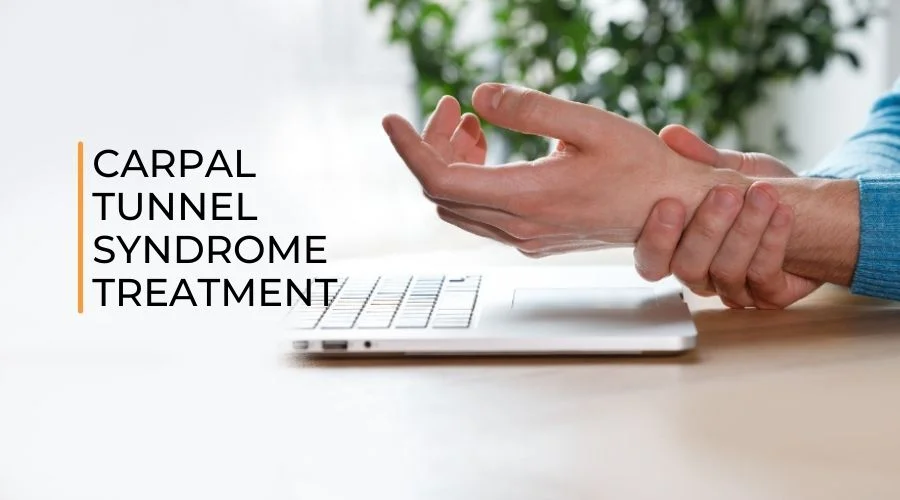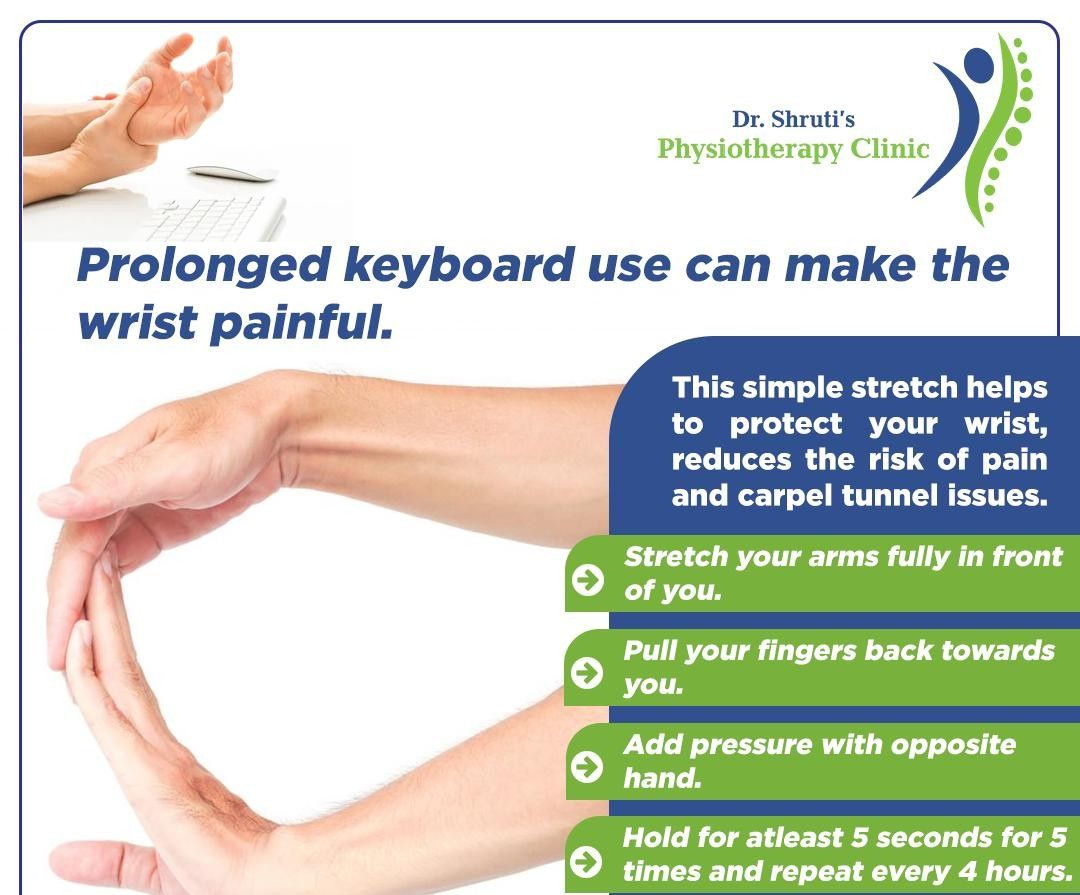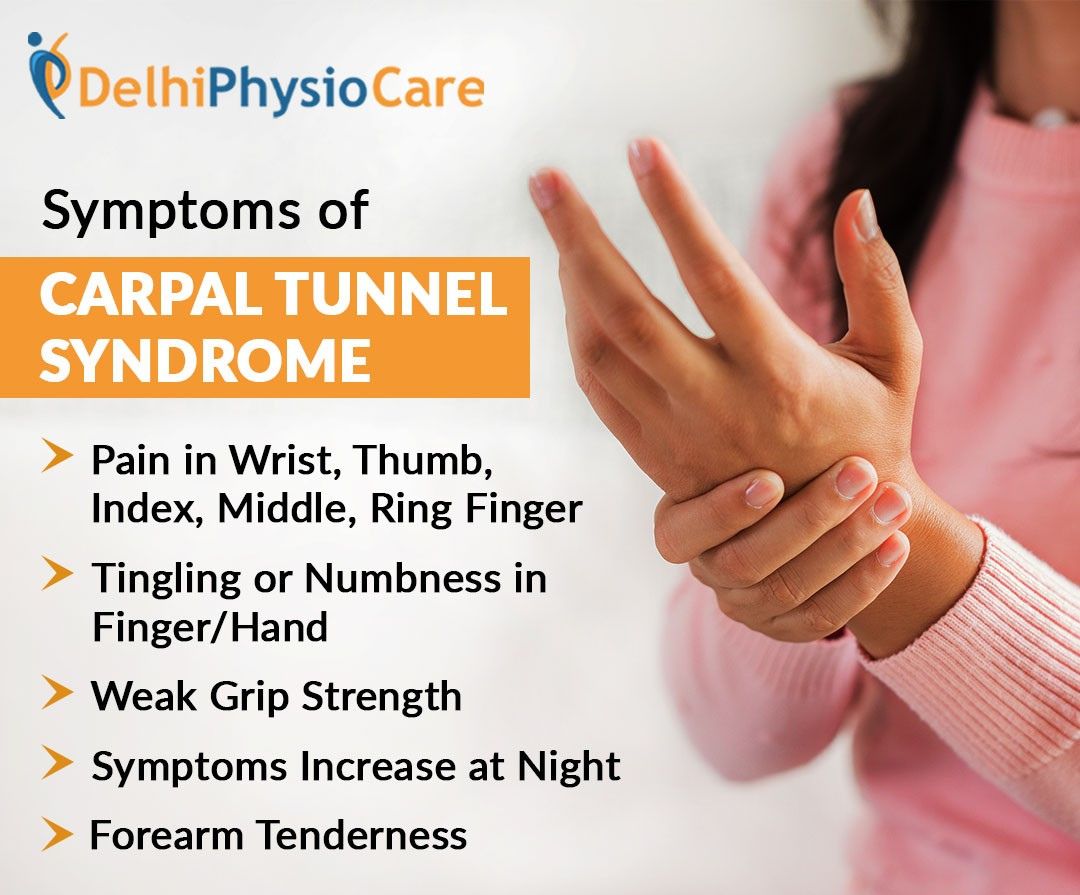Carpal Tunnel Syndrome
Home / Carpal Tunnel SyndromeCarpal Tunnel Syndrome Treatment in Delhi

The carpal tunnel is a narrow passageway on the palm side of your wrist which is bound by bones and ligaments. A variety of factors can contribute to carpal tunnel syndrome, including your wrist anatomy, certain underlying health problems, and hand use patterns.

This tunnel protects a major nerve to your hand and the nine tendons that bend your fingers. Compression of the nerve causes numbness, tingling, and eventually hand weakness that characterize carpal tunnel syndrome. Fortunately, treatment for carpal tunnel syndrome often relieves tingling and numbness and restores wrist and hand function for most people.
Symptoms

Carpal tunnel syndrome begins with numbness or tingling in your thumb, index, and middle fingers.
Tingling or numbness in the fingers or hand is a common sign of carpal tunnel syndrome, but your thumb, index, middle, and ring fingers may be affected, but not your little finger. It can be associated with pain in your wrist and hand.
This sensation can be felt from your wrist to your arm when you hold a steering wheel, a phone, or a newspaper or, more frequently, when you are awake. Many people shake their hands to try to relieve their symptoms, but the numb feeling may become constant as the disorder progresses.
Causes
Carpal tunnel syndrome is a complication of the median nerve, which runs from your forearm to your hand by passing through a narrow opening in your wrist (carpal tunnel). With the exception of your little finger, it provides sensation to the palm side of your thumb and fingers, and nerve signals are delivered to the muscles near the base of your thumb (motor function).
It can be caused by anything that narrows the carpal tunnel and irritates the median nerve in the carpal tunnel space, including a wrist fracture or swelling and inflammation from rheumatoid arthritis. It is possible that a combination of risk factors is responsible for the development of the illness in many cases.
Risk Factors
Multiple factors have been linked to carpal tunnel syndrome, and while they themselves don’t cause the syndrome, they may increase the risk of developing or provoke median nerve damage.
This includes:
- Anatomic factors – A wrist fracture or dislocation that changes the space within the carpal tunnel can put extraneous pressure on the median nerve.
- Gender – People with smaller carpal tunnels may be more likely to suffer from carpal tunnel syndrome. Carpal tunnel syndrome is more common in women, perhaps because the carpal tunnel is smaller than in men, leaving less room for error. Women who have carpal tunnel syndrome may also have smaller carpal tunnels than women without the condition.
- Nerve-damaging conditions – Some chronic diseases, such as diabetes, increase the risk of nerve damage, including damage to the median nerve. Rheumatoid arthritis, for example, can irritate the tendons in your wrist, putting stress on your median nerve.
- A change in the balance of body fluids – Fluid retention, which is common during pregnancy or menopause, can increase pressure within the carpal tunnel, thereby irritating the median nerve. Carpal tunnel syndrome during pregnancy usually goes away on its own.
- Other medical conditions – Menopause, obesity, thyroid problems, and kidney disease may increase your risk for carpal tunnel syndrome.
- Workplace factors – It is possible that flexing the wrist repeatedly or repeatedly with vibrating tools on an assembly line creates severe pressure on the median nerve or worsens existing nerve damage. But the scientific evidence is complex, and these factors haven’t been proven to be direct causes of carpal tunnel syndrome.
Many studies have tested whether there is a link between computer use and carpal tunnel syndrome. Even though extensive computer use could cause a different kind of hand pain, there is not enough high-quality and consistent evidence to support it as a risk factor for carpal tunnel syndrome.
Prevention
There are no proven ways to prevent carpal tunnel syndrome, but you can reduce the impact of physical activity on your hands and wrists by taking the following precautions:
- For prolonged handwriting, use a big pen with an oversized, soft grip adapter and free-flowing ink, as your work might involve a cash register, for example. This way, you don’t have to grip the pen as tightly or press the paper as hard.
- Take frequent breaks. Give your hands and wrists a rest by gently stretching and bending them periodically, and always alternate tasks when possible.
- When you use vibrating equipment or use anything that requires you to exert a lot of force, taking breaks becomes more important.
- Watch your form. Avoid curling your wrist all the way up or down; prefer a relaxed middle position.
- Keep your hands warm. If you work in a cold climate, you’re more likely to develop hand pain and stiffness. If you can’t regulate the temperature at work, wear fingerless gloves that keep your hands and wrists warm.
Physiotherapy Treatment in Carpal Tunnel Syndrome
Carpal tunnel syndrome is the most common compressive neuropathy of upper limb. Compression of the median nerve at the palmar aspect of the wrist causes pain, numbness , tingling and some other neurological symptoms in the thumb, index, middle and half of ring finger ( 3 ½) fingers.
The main aims of physiotherapy are –
- Relieving pain
- Improving strength and mobility in the wrist and fingers
- Guidance and education of the patient regarding his lifestyle and aggravating symptoms
- Preventive measures
- In case of surgery; post-op rehab
Remember “prevention is better than cure” so if your body is giving you signs listen to it. Carpal tunnel syndrome will cause the symptoms mainly in the wrist and hand. In some cases , it might be getting referred till the forearm. It almost never shows any symptoms in the neck or shoulder. Hence, it is easy to diagnose.
The main reason seen for this condition is repetitive and prolonged use of the wrist in the same position. It could be working on the computers for a long time (typing) where the wrist stays in the same position for a long time.
It is also seen in professions where some vibratory movements of the wrist are involved (working on certain machines).
Stop Or Reduce The Activities That Aggravate Your Symptoms
- Avoid repetitive movements. Take frequent breaks.
- It is very important to adjust your desk and chair at work. When working on the computer, the placement of the keyboard makes all the difference. Keyboard should not be kept too far away. Elbows should be close to your body when you are typing. They should be at about 90 degrees. Key board should be placed such that hand can work comfortably on it, so just below the elbow, shoulders and neck should be relaxed. Wrist in neutral position and back supported well, fingers should be relaxed while typing and type lightly without putting too much pressure on the fingers.
- Pull your chair near the desk while working, taking care of your posture, your neck, shoulders, forearm, wrist and fingers.
- Gently shaking the wrist and spreading fingers apart during breaks are good exercises to do.
Multiple modalities can be chosen from to provide relief in case of carpel tunnel syndrome;
- Hot/cold packs, US therapy, TENS, laser therapy. These provide relief in pain but none in sensory deficit.
- Try to keep wrist and hands warm. Wear gloves if needed. Cold aggravates the symptoms.
- It is difficult to manage the wrist position in sleep, a night splint is suggested for the same. It keeps the wrist in neutral position. It takes about 2-3 weeks to get used to wearing splint and for the results to show.
Certain exercises are recommended which are customized for each individual keeping his symptoms and lifestyle in mind.
- Stretching exercises; for wrist, hand and fingers to improve flexibility.
- Strengthening exercises; for hand, wrist and forearm when the symptoms start decreasing.
- Functional exercises ; that help in activities of daily living.
A few simple exercises are;
- Wrist bends{forward and backward}
- Finger bend
- Ball squeezes.
It is important to do all exercises under supervision and avoid those that aggravate the pain or numbness. If physiotherapy and medical treatment is not helping you, you must meet with a surgeon and plan a surgery if advised.
Physiotherapy will help you post surgery in getting back your strength and functional mobility.
Quick Enquiry
Send us a message with your contact details and one of our staff will contact you right away.
TREATMENTS
BOOK AN APPOINTMENT
GENERAL ENQUIRIES
235, Avtar Enclave,Paschim Vihar,Delhi – 110063
Carpal Tunnel Syndrome FAQ’s
Physiotherapy is essential to manage carpal tunnel syndrome, build muscle and improve function, but therapy alone is not always enough to solve the problem.
The therapy patients receive weekly half-hour manual therapy sessions during which only their hands were used, with our physical therapists focusing on the neck and the median nerve.
Carpal tunnel syndrome (CTS) is a common cause of hand pain and numbness, and it is often caused by overuse. Fortunately, if you’re suffering from this common injury, you do not have to stop exercising or attending your favorite fitness classes.
Carpal tunnel syndrome is caused by repeated fingers and wrist movements, awkward hand movements, vibrations, and mechanical strain on the palm. Most tasks involving CTS involve strong pulling, pulling, pushing, or twisting.
Most racket sports, handball, swimming, bodybuilding, rowing, golf, archery, and rock climbing have high rates of carpal tunnel syndrome, although any sport that requires the wrist and hand to be used for extended periods can be affected.
Numbness and tingling in the fingers can occur in as little as 60 seconds for those with carpal tunnel syndrome, and the sooner symptoms are felt, the worse the carpal tunnel syndrome. If there is limited wrist motion, arthritis, or a history of trauma, X-rays of the wrist may be required.
You may first experience periodic tingling or numbness in your fingers. The sensations may get worse over time, lingering longer or even waking you up at night. If you continue to ignore carpal tunnel, it may lead to permanent nerve damage.
